Did you know beaches are a great place to find hidden gems and artifacts in heaps of treasure!? Okay, okay, maybe not exactly pirate treasure. But you can certainly enjoy some fun and find potentially valuable items with this fun outdoor hobby!
So that brings us to the topic on hand: what is beachcombing?
So, What is Beachcombing?
Well, beachcombing is the activity of searching for and collecting, items that have washed ashore on beaches.
This relaxing pastime allows individuals to explore the shoreline, enjoy the outdoors, and discover hidden treasures. It’s also a fun activity to do when you’re bored.
Beachcombing treasures can include looking for shells, sea glass, driftwood, and even artifacts or items lost at sea.
Some beachcombers are motivated by the thrill of the hunt, while others enjoy the serenity of spending time by the water.

Article Contents:
How to start Beachcombing
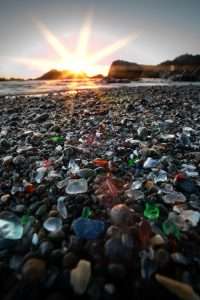
Beachcombing is an accessible and enjoyable activity for people of all ages and requires little or no skill!
Whether you’re a seasoned veteran or a beginner beachcomber looking to start a new hobby, these tips and tools will help you make the most of your new adventures.
Beachcombing is an accessible and enjoyable activity for people of all ages and requires little or no skill!
Let’s take a look at how to start beachcombing!
-
Choose a beach to search

Do some research! Find a beach near you or one that is known for beachcombing which may have a reputation for unique finds.
-
Check the tide times
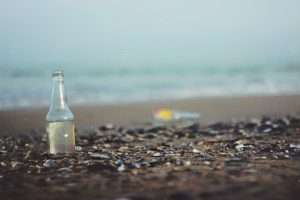
A common method of beachcombing is to go searching during low tide. This reveals more of the beach and exposes areas that may otherwise be covered by water.
-
Dress appropriately & gather your tools and equipment

Depending on the time of day and season – you want to dress appropriately! This is supposed to be a fun hobby! Best to be comfortable while enjoying yourself.
-
Start Combing the Beach
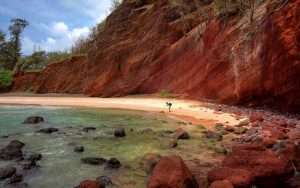
Walk slowly along the beach – scanng the sand, rocks, and debris for interesting items.
-
Use your tools
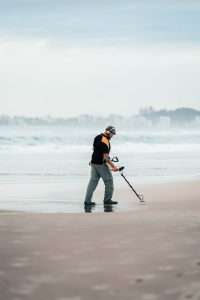
If you’ve brought tools to assist you, make sure to use them! Metal detectors, scoops, rakes, or any other tool you decided to bring with.
-
Collect items you find
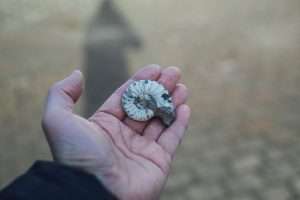
Once you find something interesting, collect it in the bag you’ve brought along with you!
-
Go out regularly
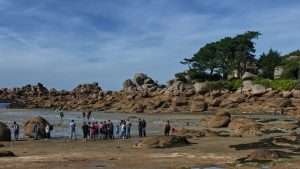
You may come away with your beachcombing session without anything fun or valuable. That’s okay! Go out again, scan different portions or the beach, or choose another beach!
Beachcombing Tools

While this relaxing hobby can be done with just your eyes and hands, some tools can enhance your experience and make it easier to find and collect items. Especially if you’re a beachcombing beginner!
- A beachcombing bag: A mesh bag or a bag with compartments is ideal for holding and separating your finds.
- A small shovel or scoop: Useful for digging out partially buried items or sifting through sand.
- A metal detector: Helpful for finding metal objects, like coins or jewelry, buried beneath the sand.
- A magnifying glass: A handy tool for examining small or intricate items up close.
- A walking stick or pole: Helps with stability on uneven terrain and can be used to move seaweed or debris.
Tips & Tricks to Beachcombing:
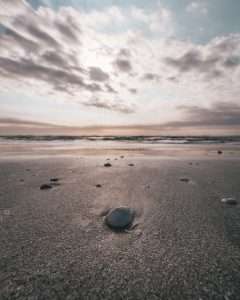
- Check the tide times: Low tide is the best time to beachcomb, as it exposes more shoreline for you to explore. Check local tide charts or use a tide-tracking app to plan your beachcombing trip.
- Dress appropriately: Wear comfortable clothing, a hat for sun protection, and waterproof shoes or sandals that can handle wet and rocky terrain.
- Bring a bag or container: Have a bag, bucket, or other container handy to collect and transport your finds.
- Look for debris lines: Items often accumulate along the high tide line, so focus your search on these areas.
- Be patient and persistent: Beachcombing is a leisurely activity that requires patience and a keen eye for detail. Take your time and enjoy the process of searching for treasures.
Beachcombing Treasures & Finds
Beachcombing can yield a wide variety of treasures, from common finds like shells and sea glass to rare and unique items that have a fascinating story to tell.
Here’s a look at some of the items you might discover!
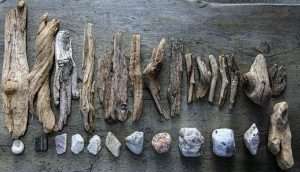
Common Beachcombing Finds:
- Shells: Shells are the most common find for beachcombers. They come in many shapes, sizes, and colors, making them popular collectibles.
- Sea glass: Sea glass is formed when broken glass is smoothed and frosted by the ocean’s waves. Collectors value sea glass for its unique appearance and colors.
- Driftwood: Driftwood is wood that has been washed ashore by waves, wind, or tides. It can be used for crafting or as a natural decoration.
- Seaweed and marine plants: Beachcombers often find various types of seaweed and marine plants washed ashore. Some can be used for cooking or medicinal purposes.
- Fossils: Fossilized remains of plants and animals can sometimes be found along the shoreline, offering a glimpse into the ancient past.

Rare and Unique Beachcombing Treasures You may find:
- Message in a bottle: Although rare, beachcombers have occasionally found messages in bottles that have traveled vast distances across the ocean.
- Whale bones or teeth: Larger marine creatures, such as whales, can sometimes wash ashore, leaving behind bones or teeth for beachcombers to discover.
- Shipwreck artifacts: Items from shipwrecks can wash up on shore, offering a fascinating connection to maritime history.
- Ancient coins or jewelry: It’s uncommon but not unheard of for beachcombers to find coins, jewelry, or other valuable items that have been lost at sea or buried in the sand for centuries.
- Meteorites: On very rare occasions, beachcombers have discovered meteorites on the shoreline, making for an out-of-this-world find.
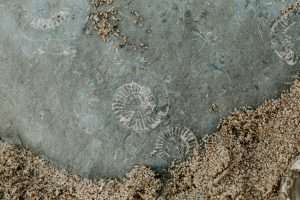
Remember that every search is unique, and you never know what you might uncover.
The excitement of the hunt is what makes this hobby so enjoyable.
What is a Beachcomber?
A beachcomber is someone who participates in the activity of beachcombing as a hobby.
They might be casual enthusiasts who enjoy the occasional shoreline stroll or dedicated collectors in search of specific items. Some beachcombers even turn their finds into art or sell them as collectibles.
The History of Beachcombing
Beachcombing has a rich and fascinating history that spans across different cultures and time periods. From being a means of survival to evolving into a leisure activity which continues to capture the interest of people all over the world.

Early Beachcombers
Ancient people living on islands or along coastlines relied on beachcombing for survival. They searched the shore for useful items like shells, seaweed, and driftwood, which were essential for building materials, tools, and food.
Indigenous peoples of the Pacific Northwest, for example, collected shells to use as currency or traded them with neighboring tribes. This activity was a crucial aspect of their way of life.
Beachcombing as a Leisure Activity
The 19th century saw beachcombing transform into a recreational activity as seaside tourism became popular.
Vacationers and locals alike enjoyed strolling along the shoreline and collecting interesting items that washed ashore, leading to its widespread appeal.
The Golden Age of Beachcombing
The early 20th century marked the golden age of the activity, with people appreciating the beauty and value of their shoreline finds.
Collecting shells, sea glass, and other treasures became a popular hobby.
Various clubs, guidebooks, and magazines were created and further fueled the growing interest in this leisurely pursuit.
Modern Beachcombing
Today, beachcombing remains a popular activity enjoyed worldwide. Technological advances have led to specialized tools and equipment for beachcombers, while the internet provides a bunch of fun websites for enthusiasts to share their finds, tips, and experiences.
As a result, this hobby continues to grow in popularity as a fun and engaging pastime.
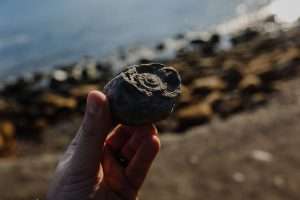
Best Beaches for Beachcombing
While beachcombing can be enjoyed on virtually any shoreline, some beaches are known for their exceptional finds and unique treasures.
Here’s a list of some of the best beachcombing beaches around the world:
- Sanibel Island, Florida, USA: Known for its abundant seashells, Sanibel Island is a beachcomber’s paradise. The island’s unique east-west orientation allows for a variety of shells to accumulate along its shores.
- Glass Beach, California, USA: This beach in Fort Bragg is famous for its sea glass, which covers the shore in a colorful mosaic. The glass is a result of years of trash dumping, which has since been transformed by the ocean into beautiful sea glass.
- Botany Bay, England: Located in Kent, Botany Bay is known for its chalk cliffs and abundant fossils. Beachcombers can find prehistoric shark teeth, ammonites, and other marine fossils.
- Charmouth Beach, England: Another renowned fossil-hunting location, Charmouth Beach is part of the Jurassic Coast World Heritage Site. Fossil hunters can find ammonites, belemnites, and even the occasional marine reptile.
- Shipwreck Beach, Hawaii, USA: Shipwreck Beach on the island of Lanai is named for the numerous shipwrecks that have occurred in the area. Beachcombers can find bits of pottery, glass, and other artifacts from these shipwrecks.
- Jeffreys Bay, South Africa: Known for its surfing, Jeffreys Bay is also a great spot to look for treasures. The beach is home to various shells, including the rare and coveted pansy shell.
Remember, the best beach for to try searching is often the one closest to you.
Start exploring your local shorelines and see what treasures you can uncover.
Beachcombing Etiquette & Environmental Considerations
While beachcombing is a fun and engaging activity, it’s essential to be mindful of the environment and practice responsible habits.
Here are some beginner tips to ensure that your adventures are both enjoyable and eco-friendly.

Leave Wildlife Alone
Wandering the shores can sometimes lead to encounters with marine animals, like crabs or starfish.
Observe them from a distance, but avoid disturbing or handling them. Keep in mind that some animals may be protected by local laws, and it’s important to respect their habitats.
Do Not Overharvest
While collecting shells, sea glass, and other items can be exciting, remember not to take too much from the beach.
Overharvesting can harm the local ecosystem and deprive others of the chance to enjoy beachcombing finds.
Practice moderation and only collect items that you truly appreciate.

Tread Lightly
Be cautious when walking on the beach, as you may inadvertently step on fragile shells, marine life, or sensitive plants.
Stay on designated paths where possible and avoid walking on sand dunes or other sensitive areas.
Leave No Trace
Always practice “Leave No Trace” principles by packing out any trash or belongings you bring to the beach.
By keeping the shoreline clean, you’ll help preserve the environment for future generations of beachcombers.
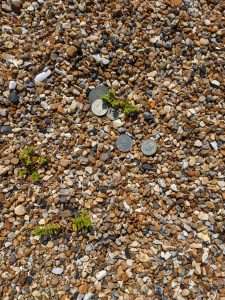
Respect Local Rules and Regulations
Different beaches may have specific rules and regulations related to beachcombing.
Some areas may prohibit the collection of certain items or restrict access to specific parts of the shoreline.
Familiarize yourself with local guidelines and follow them to ensure a responsible experience.
By adhering to these principles, you can enjoy this new hobby while minimizing your impact on the environment and preserving the shoreline for others to enjoy.

The Beachcombing Community & Resources
The beachcombing community is a supportive and passionate group of people who love to share their finds, knowledge, and experiences. This community is friendly to beachcombing beginners or folks looking to explore this hobby.
By connecting with fellow beachcombers, you can learn more about this engaging pastime and share in the excitement of discovering shoreline treasures.
Clubs and Organizations
Joining a club or organization is a great way to meet like-minded people and learn more about the hobby.
Many clubs host different events, workshops, and field trips where members can share tips, trade finds, and explore new beach locations.
Online Communities
There are numerous online forums, social media groups, and websites dedicated to beachcombing, where enthusiasts can connect, share their finds, and ask questions. Some popular platforms include:
- Facebook groups: Search for beachcombing-related groups on Facebook to join discussions and share your finds with others.
- Instagram hashtags: Use hashtags like #beachcombing, #seaglass, and #shells to discover and connect with fellow beachcombers on Instagram.
- Beachcombing blogs and websites: Many beachcombers maintain blogs or websites where they document their adventures and findings, providing valuable insights and inspiration.

Books and Magazines
Books and magazines can be a valuable resource for beachcombers looking to expand their knowledge and improve their skills. There is a lot of reading materials on beachcombing for beginners, as well!
Some popular titles to read on Beachcombing:
- “The Beachcomber’s Guide to Seashore Life” by J. Duane Sept
- “Pure Sea Glass: Discovering Nature’s Vanishing Gems” by Richard LaMotte
- “The Ultimate Guide to Sea Glass” by Mary Beth Beuke
- “Beachcombing Magazine”: A bi-monthly publication featuring articles, tips, and stories from around the world.
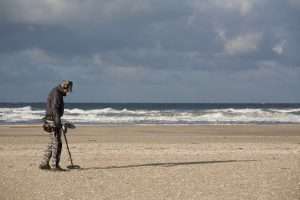
Beachcombing Events and Festivals
Attending events and festivals can be a fun and educational way to connect with fellow enthusiasts, learn new techniques, and discover new locations.
Some popular events include:
- The International Beachcombing Conference
- The North American Sea Glass Festival
- The UK Beachcombing Festival
By engaging with the community and utilizing available resources, you can deepen your appreciation for this fascinating hobby and create lasting connections with fellow beachcombers.
Frequently Asked Questions (FAQs) about Beachcombing:

To further enhance your understanding of beachcombing, let’s address some frequently asked questions about the hobby.
Is beachcombing legal?
Yes, it is generally legal, but local laws and regulations may vary. Certain items, such as artifacts, fossils, or marine life, may be protected or regulated.
Always familiarize yourself with local guidelines and follow them to ensure responsible beachcombing.
Can I sell my beachcombing finds?
Yes! Many beachcombers sell their finds, either as raw materials or as part of handcrafted jewelry, artwork, or home decor.
However, be aware of any local regulations that may limit or prohibit the sale of specific items.
Is beachcombing a seasonal activity?
Beachcombing can be enjoyed year-round, but certain seasons may offer better opportunities for specific finds.
For example, winter storms can wash up more debris and treasures on the shoreline, while spring and summer months may be more comfortable due to warmer weather.
How can I identify my beachcombing finds?
There are several resources available to help identify your finds, such as field guides, online forums, and social media groups.
Additionally, experts at museums, aquariums, or local beachcombing clubs may be able to assist with identification.
What should I do if I find something hazardous while beachcombing?
If you encounter hazardous materials, such as needles, medical waste, or toxic substances, avoid touching them and immediately report the find to local authorities or beach management.
They will provide guidance on proper disposal or cleanup.
Can you make money beachcombing?
Yes! If you find items that are valued by others, or you create items out of your collection – you can certainly make money with this hobby.
By understanding the ins and outs of beachcombing, you can fully immerse yourself in this engaging and rewarding pastime. Enjoy the adventure of discovering hidden shoreline treasures and connecting with the community.
Conclusion

Beachcombing offers a unique and enjoyable way to explore the shoreline, discover hidden treasures, and connect with nature.
This engaging pastime can be enjoyed by people of all ages and skill levels, making it an ideal activity for those seeking a new hobby or looking to break free from boredom.
By following the tips and guidelines provided in this comprehensive guide, you can embark on a new adventure that is both fun and environmentally responsible.
As you dive into the world of this fascinating hobby, you’ll uncover a vibrant community of enthusiasts, fascinating finds, and endless opportunities to learn and grow.
So, grab your gear, head to the nearest beach, and let the treasure hunt begin!
Useful resources:

Hey Everyone!
Chritt here. I just want to say THANK YOU SO MUCH for visiting Boredom Busted. It’s been my passion project going on 7 years now.
I need a favor though. If you have found the page you landed on or explored useful in any ways – please please please share, or comment.
The more engagement on this page – the more I can continue to write and provide helpful content to my visitors like you.
I love you all and thank you again for visiting! Don’t be a stranger and hope to see you back, soon!

